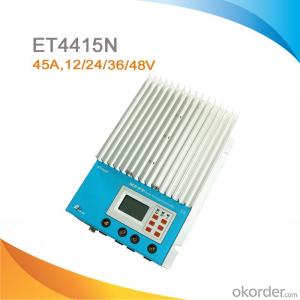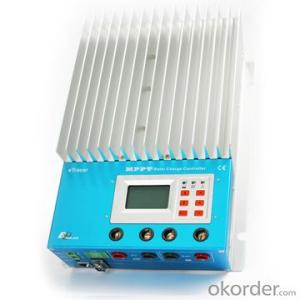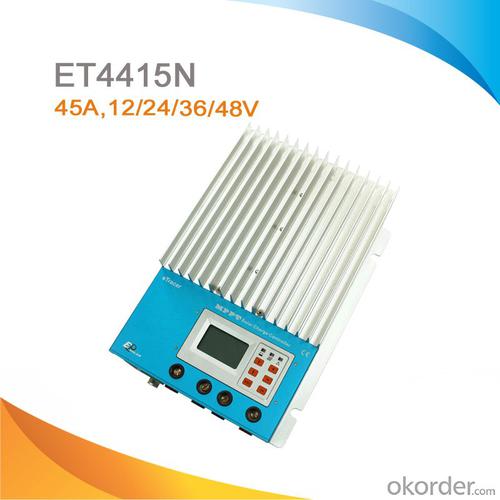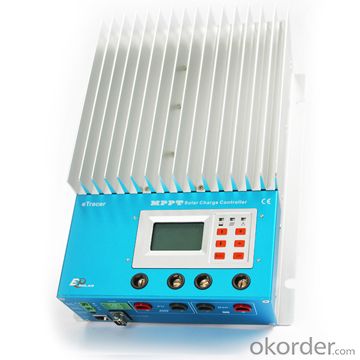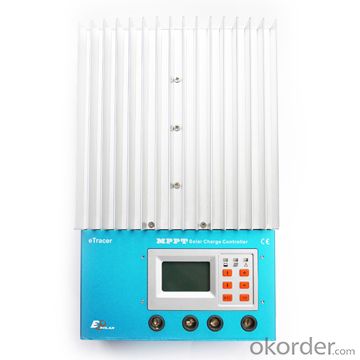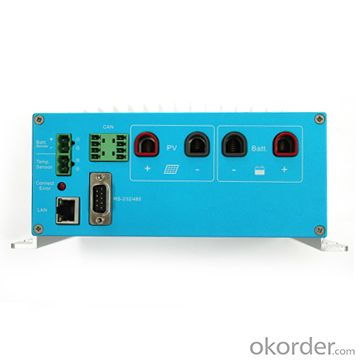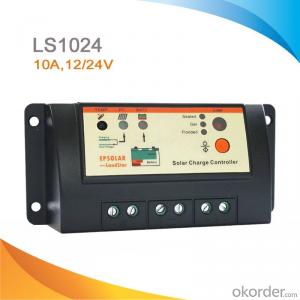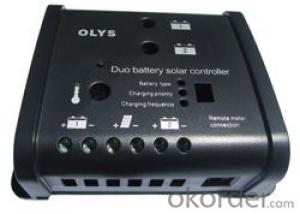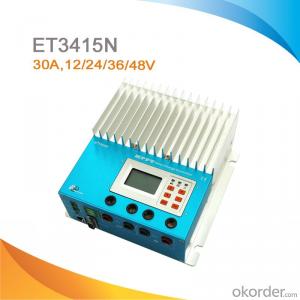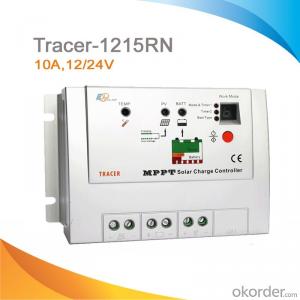Multiple Solar Controllers MPPT Solar Street Light Charge Controller 45A, 12/24/36/48V, ET4415N
- Loading Port:
- China main port
- Payment Terms:
- TT or LC
- Min Order Qty:
- -
- Supply Capability:
- -
OKorder Service Pledge
OKorder Financial Service
You Might Also Like
Specifications
MPPT charge controller
Maximum power point tracker
temperature compensation
LCD display
Communicate with PC
Features:
·12/24/36/48V auto work
·Advanced MPPT technology
·Several seconds tracking speed
·High Tracking efficiency of 99%
·Multiphase synchronous rectification technology
·Peak conversion efficiency of 98%
·DSP&ARM processors architecture ensures high speed and performance
·Gel, Sealed, Flooded battery option
·Max. 450 days data logging by connection to PC
·Multifunction LCD displays system data and status
·Three kinds of communication ports :RS232, CAN BUS and Ethernet
·Three stages charging optimizes battery performance
·Software update by users
Specification:
Model | ET3415N | ET4415N | ET6415N |
Rated system voltage | 12V/24V /36V/48V auto work | ||
Rated battery current | 30A | 45A | 60A |
Max. PV open circuit voltage | 150V | ||
Voltage range | 8~72V | ||
Max.PV input power | 400W (12V) | 600W (12V) | 800W (12V) |
800W (24V) | 1200W (24V) | 1600W (24V) | |
1200W (36V) | 1800W (36V) | 2400W (36V) | |
1600W (48V) | 2400W (48V) | 3200W (48V) | |
Self-consumption | 1.4~2.2W | ||
Grounding | Negative | ||
Dimension | 231x203x105mm | 285x203x105mm | 285x203x121mm |
Terminal | 35mm2 | 35mm2 | 35mm2 |
Net Weight | 4.1kg | 4.4kg | 5.0kg |
Working temperature | -25℃~+55℃ | ||
Storage temperature range | -30℃~+85℃ | ||
Humidity | 10%-90% NC | ||
Enclosure | IP20 | ||
Altitude | ≤3000m | ||
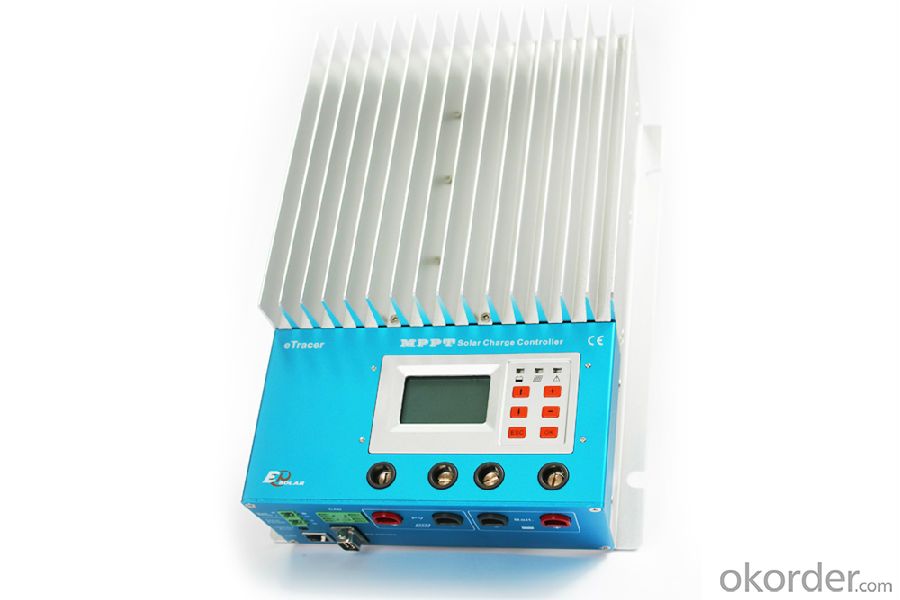

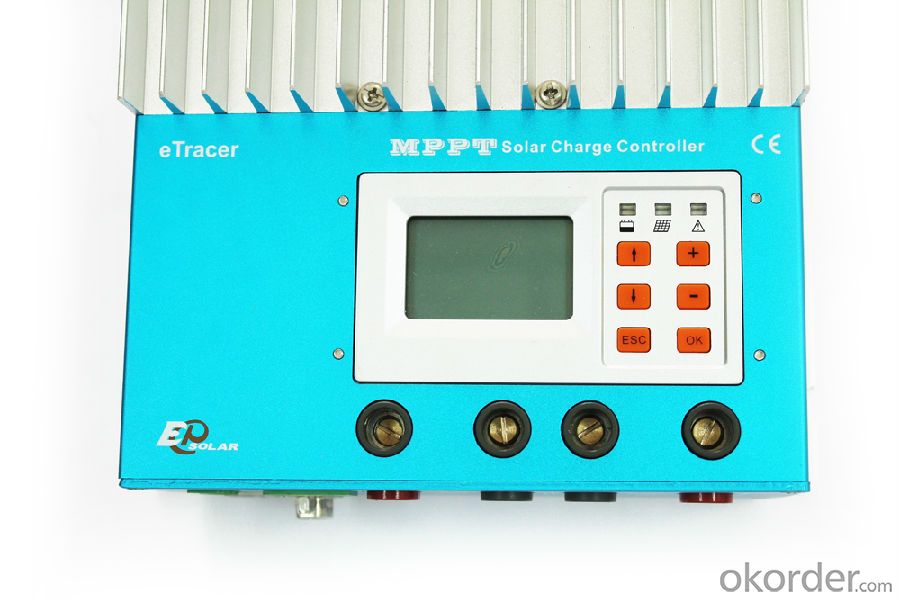
FAQ:
Q1. What is the voltage?
A1. Our 45/60A solar charge controller is 12/24/36/48V auto work.
Q2. What is the difference between MPPT&PWM?
A2. MPPT has higher efficiency, it can track the max power point and won't waste energy.
Q3. What is the efficiency of the MPPT controller?
A3. MPPT>99%, peak conversion efficiency>98%.
Q4. What is the waranty of product?
A4. 12 months.
Q5. What protection does your MPPT controller have?
A5. PV array short circuit, PV reverse polarity, Battery reverse polarity, Over charging, Output short circuit.
- Q: Can a solar controller be used with different types of solar panel backup systems?
- Yes, a solar controller can be used with different types of solar panel backup systems. The solar controller's primary function is to regulate and optimize the charging process of the solar panels to the backup system's battery. It is compatible with various types of solar panel backup systems, including off-grid, grid-tied, and hybrid systems, ensuring efficient power generation and storage regardless of the system configuration.
- Q: Can a solar controller be used with solar-powered streetlights?
- Yes, a solar controller can be used with solar-powered streetlights. A solar controller regulates the voltage and current from the solar panels to ensure efficient charging of the batteries used in solar-powered streetlights. It helps manage the charging process and protects the batteries from overcharging or discharging.
- Q: How does a solar controller prevent voltage instability in the system?
- A solar controller prevents voltage instability in a system by regulating and controlling the flow of electricity from the solar panels to the battery. It ensures that the voltage supplied by the solar panels matches the voltage requirements of the battery, thus preventing overcharging or undercharging. Additionally, a solar controller monitors the voltage and temperature of the battery and adjusts the charging process accordingly to maintain optimal performance and prevent any voltage fluctuations that could lead to instability in the system.
- Q: Can a solar controller be used with solar panel RV mounts?
- Yes, a solar controller can be used with solar panel RV mounts. In fact, it is highly recommended to use a solar controller with solar panel RV mounts as it helps regulate the charging process and prevents overcharging of batteries, ensuring optimal performance and longevity of the system.
- Q: Can a solar controller be used in a mobile solar system (e.g., RV, boat)?
- Yes, a solar controller can be used in a mobile solar system such as an RV or boat. A solar controller helps regulate the charging process of the batteries and prevents overcharging, which is crucial in maintaining the health and longevity of the batteries in a mobile solar system.
- Q: What is the maximum load voltage that a solar controller can handle?
- The maximum load voltage that a solar controller can handle can vary depending on the specific model and manufacturer. However, in general, most solar controllers can handle load voltages ranging from 12 volts to 48 volts.
- Q: How does a solar controller prevent battery under-temperature?
- A solar controller prevents battery under-temperature by monitoring the temperature of the battery and regulating the charging process accordingly. It ensures that the battery is not charged when it is too cold, as this can lead to damage or reduced performance. Instead, the solar controller either reduces or completely stops the charging process until the battery reaches a safe temperature range for charging.
- Q: What is the maximum current rating of a solar controller?
- The maximum current rating of a solar controller can vary depending on the specific model and type of controller. It typically ranges from 10 amps to 60 amps, but higher-rated controllers are also available for larger solar systems.
- Q: How the solar panels with the controller
- Light control on + delay off - open delay + light control off the double time mode: the work process is open when the dark load (light control on), delay to set the first time after the closure of the load, turn off the load After the day until the day before the set of the second time to open the load again, to the dawn when the load off (light control off), the night when the load is closed to save power. The controller uses fuzzy control to automatically identify and effectively correct the darkness to the dawn of the entire night time, that is, according to the length of the night to automatically adjust the time to close the load at night to ensure that the load only in the dark and before dawn Set the time period to open, the other time is closed.
- Q: Can a solar controller be used in a solar-powered street lighting system?
- Yes, a solar controller can be used in a solar-powered street lighting system. A solar controller is an essential component that manages the charging and discharging of batteries in a solar system. In a solar-powered street lighting system, the solar controller ensures the batteries are charged efficiently during the day and controls the power supply to the street lights during the night, optimizing energy usage and ensuring reliable operation.
Send your message to us
Multiple Solar Controllers MPPT Solar Street Light Charge Controller 45A, 12/24/36/48V, ET4415N
- Loading Port:
- China main port
- Payment Terms:
- TT or LC
- Min Order Qty:
- -
- Supply Capability:
- -
OKorder Service Pledge
OKorder Financial Service
Similar products
Hot products
Hot Searches
Related keywords
